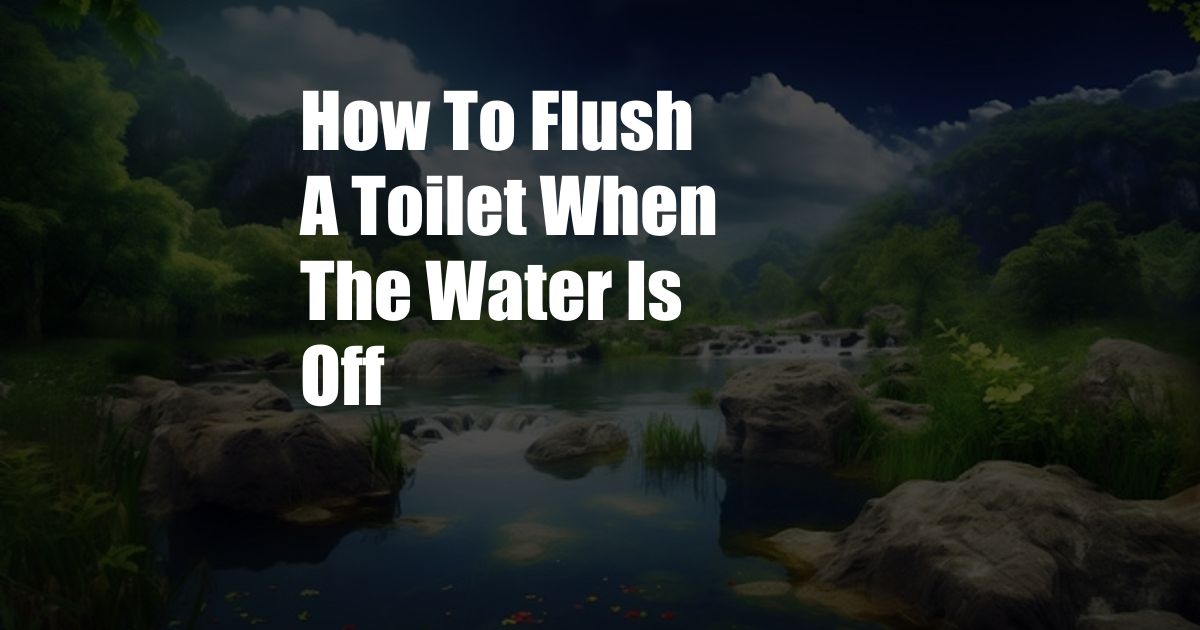
How to Flush a Toilet When the Water Is Off
Imagine this: you’re in the bathroom, nature calls, and you do your business only to realize that the water’s off! Panic sets in as you wonder how you’re going to flush that away. Don’t fret; we’ve got you covered with ingenious ways to flush a toilet when the water’s out.
Before diving into the solutions, let’s pause and appreciate the humble flush toilet, a marvel that keeps our bathrooms fresh and hygienic. Its history dates back centuries, with the first flush toilets appearing in ancient Greece and Rome. Over time, it evolved into the modern masterpiece we rely on today.
Water Displacement: The Bucket Brigade
The simplest solution is to use a bucket of water. Fill a bucket with water and pour it into the toilet bowl as you would normally flush it. The weight of the water will create enough pressure to push the waste down the drain.
If you don’t have a bucket handy, you can use any other container that holds water, such as a pitcher, pot, or even a watering can. This method is effective and doesn’t require any special tools or skills.
Gravity Assist: The Plunger Power
Another option is to use a plunger. This method is more labor-intensive but can be effective if you have a strong plunger. Place the plunger over the drain hole and push and pull vigorously. The suction created by the plunger will help dislodge the waste and force it down the drain.
This method requires some strength and coordination, but it can be a good option if you don’t have access to a bucket of water. Just be sure to clean the plunger thoroughly after use, especially if you’re using it in a public bathroom.
Chemical Magic: The Enzyme Treatment
If you have some time to spare, you can use enzymes to break down the waste. Pour a cup of enzyme cleaner into the toilet bowl and let it sit for several hours or overnight. The enzymes will digest the organic matter, making it easier to flush away when the water comes back on.
This method is less messy than the previous ones, but it does take longer. It’s also important to use an enzyme cleaner specifically designed for toilets, as other types may not be effective.
Expert Advice and Tips
Here are some tips from professionals and experienced homeowners:
- If you’re using a bucket of water, pour it slowly and steadily. Dumping the entire bucket at once can splash water everywhere and create a mess.
- When using a plunger, make sure to create a tight seal around the drain hole. If there’s any air leakage, the suction won’t be effective.
- Enzyme cleaners can be very effective, but they may not be suitable for all toilets. Read the product label carefully before using.
- If you’re in a public bathroom, it’s best to avoid using the toilet if the water is off. Find another restroom or wait until the water is restored.
FAQ on Flushing Toilets Without Water
Q: Can I use any type of water to flush a toilet?
A: It’s best to use clean water for flushing. However, if you’re in an emergency, you can use any type of water, including rainwater, lake water, or even seawater.
Q: How often should I use enzyme cleaners in my toilet?
A: Enzyme cleaners can be used regularly to keep your toilet clean and fresh. However, it’s especially important to use them if you have a septic tank, as they can help prevent clogs and odors.
Q: Is it safe to use a plunger in a public bathroom?
A: While using a plunger in a public bathroom is not ideal, it may be necessary if there’s no other option. Be sure to clean the plunger thoroughly after use, and avoid touching your eyes or mouth.
Conclusion
Knowing how to flush a toilet without water can save you from a potentially embarrassing or even unsanitary situation. By following the tips and tricks outlined above, you can keep your bathroom clean and functioning, even when the water’s off.
If you have any questions or would like to share your own experiences with flushing toilets without water, please leave a comment below. We’d love to hear from you!